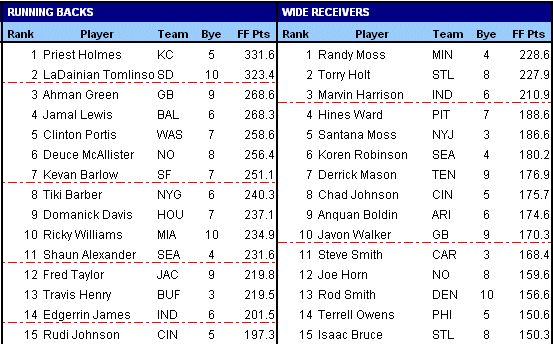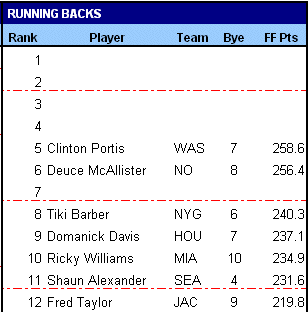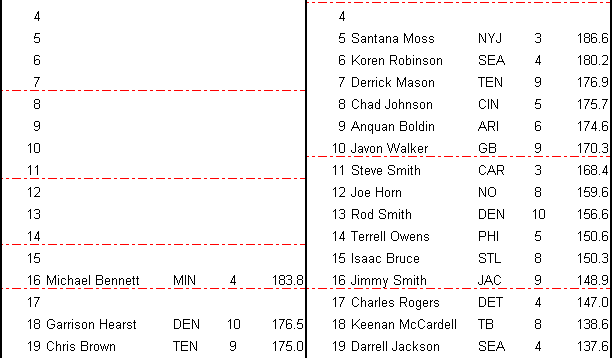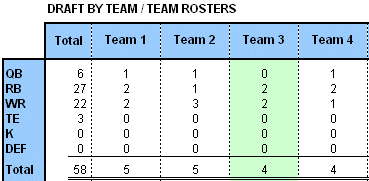Who?
If you haven't heard of Tiering before, then we'll get to what it
is in a moment. I'm trying to follow the journalism standard here,
and "Who?" comes before "What?" As way of an
intro, I'm known as the Cheatsheet Compiler and Draft Buddy guy
around these parts. The Compiler
and Buddy both include options to add dotted red lines distributed
seemingly at random throughout the positional (offense and IDP)
cheatsheets. Those dotted red lines are tier lines, and here
is an example:

Understanding what tiering is, how it works, and why it is an important
piece of your draft strategy will help you have a great draft this
summer. As an added bonus, it will leave the other owners in your
league scratching their heads how you built a team far superior
to theirs. Even if they don't figure it out after the draft, they
will soon enough when the games start!
Now we've covered the who — me, you and your league mates — let's
move on to what exactly tiering is.
What?
Tiering, sometimes called bucketing or drop-offs, is a concept
of grouping players together on a cheatsheet who have similar
projected performance (projected fantasy points) for the upcoming
season. This is not a new concept but still one that does not
get as much notoriety as it should.
Grouping of players converts an otherwise typical cheatsheet
in which players are ranked 1, 2, 3, 4, etc. to one that shows
where the significant drop-offs in performance are expected at
each position. It also highlights that there are X number of players
at a position in group 1 (the top tier), Y players in group 2
(next tier), etc.
To create the tiers, the calculations are pretty straight forward.
This is all automated in the Cheatsheet Compiler, but to do it,
all you need to do is decide on a number at which point you think
there is a significant enough drop-off to warrant a new tier,
deduct it from the projected fantasy points of the top ranked
player at a position to calculate the Tier 1 lower limit, and
draw a line under the last player who's projected fantasy points
are within the lower limit. Then repeat the same process for the
next tier, and the next, working down the rankings for each position.
In the past I've suggested 16 points as the difference
for people to use, as this represents 1 fantasy point per game.
The example above uses 20 fantasy points. There is not a hard
rule on this because different fantasy scoring systems will yield
different results. Consider it a combination of art and science
to pull off just the right tier groupings.
Pick a number like 20 and push the calcs. This is the science
part. Then review the tiers and see if they provide a reasonable
distribution of players. Not too small, but not too big either.
Can you reasonably make a case that the bottom guy in a tier has
the same ball park potential for the season as the top guy in
the tier? Is there a noticeable drop in talent from players in
one tier to the next? There could be some finessing required if
you like, such as maybe I think Steve Smith should be in with
that Tier 2 group of WR above. This is the art side of the equation.
Now I'm sure to get the question, why isn't Rudi Johnson in the
same tier with Edgerrin James, when there is only 4 fantasy points
difference between them? That isn't the way to look at it. We
don't focus our attention on the specific player names and fantasy
points at this point, but rather care more about the groupings.
There are 20 points difference between Tier 4 (James' tier) and
Tier 5 (Johnson's tier). If we looked at the difference between
each individual player on the list, then we would have hardly
any tier lines at all.
 Once players are in their tiers, the goal when drafting – this
should be obvious — is to acquire as many players from the
highest groups as possible.
Once players are in their tiers, the goal when drafting – this
should be obvious — is to acquire as many players from the
highest groups as possible.
We know there are going to be differences between the projections
and actual end of season results anyway, not to mention varying
weekly results effecting our head-to-head matchups, so does it
really matter that Clinton Portis is projected 2 fantasy points
higher than Deuce McAllister? What if I think McAllister has more
upside than Portis? Should these rankings always cause me to take
Portis ahead of McAllister? Of course not. They are essentially
the same player for your fantasy squad since they are in the same
tier, and ultimately you are going to take the one you feel is
better or you are more comfortable with.
However, if I was considering taking Ricky Williams over Clinton
Portis, then that is a little more against the grain. Williams
is projected at a point where he is a Tier 3 RB, so we'd be passing
up a Tier 2 RB when there are only 2 remaining, for Williams ranked
significantly lower based on how the tiers fall. Not to mention
there are 3 other RB still available who are all considered similar
enough to Williams to be grouped in the same tier.
The important thing about tiering is to not only look at it on
a position-by-position basis, but rather the groups are going
to help us decide which position to draft now, and which to wait
on until later. It gives us an easy way to quickly assess supply
and demand of players at each position. This is where the best
benefit of tiering comes into play.
Remember, think about players in groups. You're drafting in the
3rd spot, 12 team serpentine draft back at your turn in the 2nd
round. Who do you draft from those available:

Michael Bennett is the pick. Obviously these projections have
Santana Moss ranked very high, but not high enough to separate
him from 5 other receivers in his tier. Michael Bennett on the
other hand is sitting in his small tier all by himself. If you
pass on him here, then you probably won't get another chance at
him. After the turn however, with your 3rd round pick, Santana
Moss might be gone too. But that is all right, because you'll
still have at least a couple of those Tier 2 WR to choose from.
Taking Bennett you got a better RB and a Tier 2 WR, as opposed
to a lower tier RB (Garrison Hearst, Chris Brown, and there are
more to choose from) and a Tier 2 WR.
When you put this into practice, then you're going to apply the
concept across all positions and with each pick. The overriding
idea to keep in your head will be, draft from higher, shallower
(fewer player) tiers, and wait on lower, deeper tiers.
Where?
At the draft of course. Next question.
When?
Ok, here is an important question that needs answering. When do
you apply the tiering strategy to your draft? You do it right
from the get-go really, but it gets more or less emphasis in your
decisions whether you are in the beginning, middle or later stages
of the draft. Below I describe the approach which works well for
me.
Preparing for a draft, I have an overall ranking cheatsheet and
a cheatsheet ranking each position. Both of these are created
by the Cheatsheet Compiler, and work in conjunction with some
other things in Draft Buddy.
For the early stages of the draft, I am working primarily with
the overall list. I always mock out ahead of time how I think
a draft will go to try and figure out who will be available at
each of my early picks, plus I want to know the relative value
of the positions and this is factored into the overall list. Since
in a re-draft the team is starting with nothing, all positions
need to be addressed so it makes sense to work from an overall
list.
That said, don't be a slave to the overall list. Most all the
time I will pass on a QB early because there are numerous lower
ranked QB whose upside I really like and would be happy taking
a chance on a couple of them drafted later rather than relying
on a top ranked QB. Even if the overall list says QB, I'll probably
look elsewhere, but that is mostly personal preference. I hope
this isn't even worth mentioning because you've already been beaten
over the head with it, but K and DEF are never a consideration
early or even middle of the draft, and are excluded entirely from
the overall list.
 With all picks, monitor the average draft position ("ADP")
data, tiering and other team needs around you. If there is a player
high on the overall list but with a low relative ADP that can be
drafted later, then wait on that player. If the next best players
on the overall list are at the same position and in the same tier,
quickly assess other team needs for what positions they are likely
to draft, using a chart similar to that shown here. If your opponents
are not going to pull all the players out of that tier before your
next pick, then weigh the risk-reward of waiting on that position
and strengthen your team elsewhere.
With all picks, monitor the average draft position ("ADP")
data, tiering and other team needs around you. If there is a player
high on the overall list but with a low relative ADP that can be
drafted later, then wait on that player. If the next best players
on the overall list are at the same position and in the same tier,
quickly assess other team needs for what positions they are likely
to draft, using a chart similar to that shown here. If your opponents
are not going to pull all the players out of that tier before your
next pick, then weigh the risk-reward of waiting on that position
and strengthen your team elsewhere.
Monitor tiering as early as your 1st pick when drafting late
in the round, just to make sure you aren't passing up an opportunity
to take a top tier WR like Randy Moss when there are still a few
RB you'd be happy with and one will come back to you.
The usefulness of the overall list typically declines about rounds
4-5 when specific team needs are more important and must be addressed.
Now we're in the middle of the draft which is where the difference
is made between having a strong draft, and having an average draft.
Tiering plays a key part in this as we put more emphasis on it
working primarily off the rankings list by position. Continue
to follow the ADP and other team needs. Fill out your roster for
probably all your starters except K, DEF, maybe IDP and TE, and
key backups who were good drafting value.
You're going to get the best bang for your buck using tiering
and always watching other team needs drafting 3-4 spots from either
end of a serpentine draft (picks 3-4 or 9-10 in a 12 team league).
At these spots it is more predictable what positions are going
to be targeted on picks going into the turn on either end. Plus
watching the team needs you can repeatedly block out the end teams
pulling the next best player at a position they need to fill out
their roster.
Even later in the draft, still using the ranking list by position,
take a few more chances picking sleepers and high upside players
even if they are not ranked as high as others. If they flop, then
you can probably always replace them via free agency. Drafting
them late they didn't cost very much or come with high expectations
anyway. Continue to use it where possible, but tiering has less
impact here because at the bottom end of the cheatsheets the tiers
are much deeper as a lot of players have very similar projected
performance.
Flip back to the overall list to see if there is anyone who has
really fallen in the draft from where he was ranked, and consider
taking them. Get backups for your studs if necessary. And of course,
fill out that roster even taking a K, DEF, etc.
That is the draft approach, and you can see tiering is used throughout
the entire draft, but especially in the early and middle rounds.
Why?
Tiering helps you pull as much value off the board as you can
with each draft pick, which will ultimately result in building
the best possible team. It removes the tendency to get locked
into drafting certain positions at each pick, and instead helps
you take a tactical approach to the draft making the best picks
based on what is transpiring around you (other picks that are
out of your control).
The decisions are not difficult. There are not any complex formulas
you need to complete before proceeding further. The setup is all
done before hand, so under typical live draft conditions you should
have plenty of time to analyze your options, make your decision,
calmly take another drink (optional but recommended) and call
out your pick.
And the best thing tiering has going for it, is that there are
still not a lot of people who use it, or don't use it properly.
Remember when you used to have an advantage over all of your league
mates because you visited FF Today and everyone else showed up
with a magazine? Now there are no magazines in sight at the draft?
Here is your new advantage over those guys.... well, those who
don't visit FF Today, that is.
|



